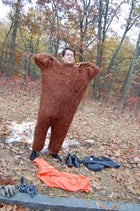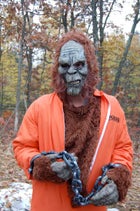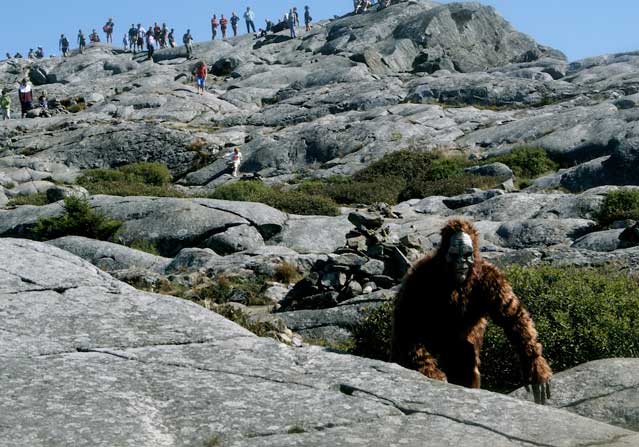On September 6, 2009, when hiker Jonathan Doyle began a tongue-in-cheek ascent up Mount Monadnock, he had no idea he was on a path to becoming a free speech activist. The 29-year-old performance artist stuffed a Bigfoot Halloween costume in his backpack and hiked to the summit with his girlfriend. At the top, he changed into the suit and interviewed random hikers with his camcorder. Had they heard about any Sasquatch sightings in the area and would they be willing to discuss such rumors?
Bigfoot goes to court
 Jonathan Doyle dresses for his day in court
Jonathan Doyle dresses for his day in courtBigfoot in chains
 Dressed for the New Hampshire Supreme Court
Dressed for the New Hampshire Supreme CourtThe New Hampshire Supreme Court
 New Hampshire's Supreme Court Justices listen to arguments concerning Bigfoot
New Hampshire's Supreme Court Justices listen to arguments concerning Bigfoot
Doyle was so pleased with that first video, “Bigfoot on Mount Monadnock,” that he returned to the state park two weeks later for a more ambitious scripted film with five friends—one dressed as Yoda and another dressed as a pirate. Aware of the amateur crew’s planned presence from some local media coverage, a park ranger met Doyle on the mountain and told him that he had received complaints from annoyed hikers. The state official ordered the crew to immediately leave because they were engaged in a full commercial film production and needed a $100 special use permit and a $2 million insurance policy for liability. Doyle did not finish his second film, “Bigfoot Captured on Mt. Monadnock.”
Annoyed that his simple video was being treated like a Stephen Spielberg production, the filmmaker brought his case to the New Hampshire Civil Liberties Union (NHCLU). They represented him pro bono in hearings before Merrimack Superior Court in 2010 and 2011. The state suggested that the Bigfoot stunt scared and endangered hikers on one of the world’s most used mountain trails. Doyle countered that the spectacle of unexpectedly seeing Bigfoot at the crowded summit provided a bonding opportunity for groups of strangers. Judge Larry Smukler sided with the state, ruling last May that Doyle's YouTube venture was “far more than a simple attempt at spontaneous expression. It was a full-fledged commercial production.”
Doyle and the NHCLU appealed. They took the case to the state Supreme Court last November, with the filmmaker claiming that the state’s permit demand was an unconstitutional violation of his right to free speech. “Benjamin Franklin once said that people willing to trade their freedom for security deserve neither and will lose both,” says Doyle, reflecting on the ordeal. “I’ve been put into this karmic situation and I felt compelled to respond. I’m a fighter.”
On November 10, Doyle showed up to the Supreme Court hearing wearing the furry suit, plastic shackles, and a bright orange prison uniform. He hoped sporting the Sasquatch outfit would bolster his claim that a schlocky Halloween costume from iParty would not have scared anyone on the trail–especially since it had a long open slit down the back. A security officer stopped him at the door and instructed him to immediately change into a sportscoat and slacks. The courtroom dress code prohibited hats; there was no way a rubber Bigfoot mask was going to pass muster.
Wardrobe details aside, the justices seemed delighted to discuss the Yeti. “Isn’t a mountain a likely venue for Bigfoot to show up?” asked Chief Justice Linda Stewart Dalianis. “People have been looking for him for a long time.”
Questioning the state’s assessment that the presence of a costumed hiker was dangerous to fellow hikers, Associate Justice Robert Lynn asked, “What’s going to happen with the six people doing the movie that wouldn’t happen with the six people just out on the hiking trail?”
NHCLU attorney Barbara Keshen said a group of local high school students recently carried a couch to the top of Mt. Monadnock and they were not stopped for endangering themselves or others. Suffering a twisted ankle while lifting furniture over boulders is an extremely plausible scenario for getting hurt, she said. Several judges said Doyle’s activity was no different from a wedding photographer snapping pictures of a bride and groom on top of a mountain or a family taking video with their mobile phone—neither of which requires a government permit. The required 30-day waiting period was also challenged as an obstacle to spontaneous political or artistic expression.
The justices ruled that the state’s permit process was unconstitutional, delighting Doyle and setting him loose to release the movie “Bigfoot Ninja” in the summer of 2012. “When I’m in the wild, the place in the world where I feel most free, it’s oppressive to have to consider petty government rules and regulations,” he says. “I’m looking forward to going back up the mountain and continuing what they interrupted.”
Still, not everyone is celebrating Doyle’s victory. “This is not a free speech issue and it’s not artistry,” says Rhettman A. Mullis, Jr., a professional Sasquatch researcher based in Seattle. “These films are mocking the species and the people who believe in it. They are all slapped-together disingenuous crap.”
Darren Garnick is an Emmy-nominated documentary filmmaker and avid hiker based in New Hampshire. He is also is the founding curator of TackyTouristPhotos.com.


